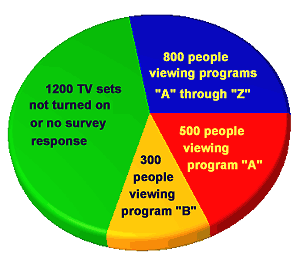Film, Radio and TV - 26 |
TV Networks
The golden age of TV was also a golden age for the television networks--except for under-financed DuMont Television Network, which struggled for a while and then folded in the mid-50s. In addition to the stalwart CBS and NBC networks, there was ABC, a new network that was trying, with increasing success, to move up. The television networks at first offered complete programs to advertisers for sponsorship, just as they had done with radio. However, after a while, some advertisers saw advantages in producing their own programs. Procter & Gamble, for example, wanted to concentrate on producing programs that had special appeal to the women, who bought most of their products. The names of some TV series were a bit of a commercial in themselves: for example, the "Kraft Television Theater" and the "U.S. Steel Hour." But, after a while, advertisers started getting too much control over program content. In some cases entire programs ended up resembling commercials. The film, Quiz Show, produced by Robert Redford, tells the story of how network and advertiser control got out of control. (The video is worth renting for its dramatic value alone.) As time went on, producing and sponsoring a complete TV series became too expensive for one company, and so the networks took back production control and offered two or more companies commercial time slots in programs. This was referred to as participation. Today, of course, programs typically carry commercials for a multitude of companies. In fact, commercial content--often referred to as commercial clutter--has been increasing each year. At the beginning of 2000, ABC, CBS, NBC, and FOX all reported more than 16 1/2 minutes of commercials per hour--up more than three minutes an hour from 1991. In addition, during this nine-year period the average number of commercials per minute has increased, due to the move to shorter commercials. Some stations now to run up to 10 commercials in a row during each commercial break. |
Since we've already mentioned the Fox Television Network, we should note that in 1987, the Fox Network was launched. Fox was the first of three new networks to appear on the scene to try to compete with the "big three": CBS, NBC, and ABC. Behind Fox is media tycoon Rupert Murdoch, an Australian who built a newspaper and TV empire in Europe and Australia. Since it isn't possible for non-citizens to own TV stations in the United States, Murdoch was able to rather quickly secure a U.S. citizenship. The U.S. government had become disenchanted with the violence and sex on the "big three" networks, and apparently thought that a new network run by a conservative such as Murdoch would reverse this. However, this is not the way it worked out. Murdoch and FOX pushed the boundaries of violence and sex in dramatic
and comedy programming even further than the other networks. (At
the same time, In 1995, United Paramount Network (UPN) and the Warner Brothers Network (WB) were launched. In the case of both WB and UPN, the main objective was to have TV station outlets for the material their associated film studios produced. Thus far, although both WB and UPN have had successful shows, neither has had the success of the other four networks.
Initially, the concept of having regular public service programming (noncommercial or sustaining programming) was important to the FCC--and, therefore, to local broadcast station owners who had some concerns about meeting FCC expectations and getting their broadcast licenses renewed every five years. Programming covering local issues did not normally yield high ratings for TV stations. Even so, it was still seen as being important to an informed citizenry. The fact that most people prefer to be entertained rather than informed was clearly evident in the ratings--although, admittedly, most public service programming of the era were weak in production values and pretty dull to watch. Gradually, as the pressure for profits increased and the power of the FCC decreased, most public service programs--especially at a time when people are most apt to be watching--fell by the wayside. Now, if these programs are broadcast at all, they are typically relegated to 6 or 7 a.m. time slots on Sunday mornings. Thus, stations can report some public service programming to the FCC. But, since little advertising revenue would be made during these off hours anyway, the stations aren't loosing much. In place of commercials in these programs, the stations typically run PSA's (non-revenue generating public service announcements) for nonprofit organizations such as the Red Cross and various government agencies.
At the network level, most 30- or 60-minute documentary programs have also disappeared. (Although other countries, such as Canada and Britain, regularly broadcast many excellent documentaries.) In the United States, full-length, hard-hitting documentaries, such as "Harvest of Shame," have all but disappeared. 'Shame," which focused on the exploitation of migrant workers, not only garnered many awards, but also put the spotlight on a major social problem.
Documentaries are also less attractive to networks because they can be expensive to produce. They generally require considerable research and production time. In addition, documentaries that tackle important topics often "step on the toes" of influential individuals and corporations. Regardless of truth, this can spark expensive lawsuits. Today, the full-length documentary void has been partially filled by highly rated programs such as "60 Minutes" and "Dateline." But, as the award-winning film, The Insider, showed, even the number one rated (and number one revenue-generating) TV newsmagazine, "60 Minutes," can be forced to back off from an important story when a large corporation with friends in high places threatens them. Networks still break away from regularly scheduled programming to cover major news events--sometimes for hours at a time. Even though there are typically commercial breaks in this coverage, millions of dollars in revenue can still be lost. This is because of the extra production costs incurred in covering these events and the lost advertising in the programming that's preempted. A good example of this was the coverage of the September 11, 2001, terrorist attacks on the East Coast of the United States. At the same time, if stations didn't cover these things, viewers would quickly tune to stations that did.
Even though we now have six basic TV networks, more than there have ever been in the United States, we have to acknowledge that the golden age for television and television networks has past. The time that U.S. viewers spend watching network television is constantly being eroded as other options come on the scene: cable and satellite programming (a few of which are illustrated below), the Internet, DVD and videotape rentals, and video games.
What "golden age" is next? Is it the golden age of the Internet? We'll explore the promised cornucopia of Internet options in a later module.
The survival of radio and TV shows depends on ratings. Since newspapers and TV programs constantly refer to the ratings of shows, understanding how they work is essential in evaluating the success of shows. They are especially critical in broadcast advertising where the cost of commercials is directly tied to ratings. Although "ratings" is the term commonly used as a measure of program popularity, shares, CPM, and HUTS are just as important. We'll explain each. By dividing the larger number (2,800) into the smaller (500) we get a percent; in this case 17.86. So the rating of program "A" is 18. (Since ratings are in terms of percentages, you don't need to say "percent," just 18.) Using the same procedure you can see that the rating for program "B" would be 11. SHARE - A share is the percentage of TV households with sets turned on that are watching your program. In the case of program "A" you divide 1,600 into 500 and get 31 as the audience share for program "A". The share for program "B" would be 18.75 or 19. In the above example 1,600 represents the HUTS, or Homes Using Television out of the total TV households in the designated area. In this case HUTS = 57% (1,600 / 2,800). CPM - Cost per thousand (not million!). When you are considering cost-effective ways of reaching potential customers it's important to be able to compare the media possibilities. To determine CPM you divide the cost of advertising by total number of people reached by the advertisement (in thousands) . If a radio commercial costs $100 and reaches 50,000 people your CPM would be $2 (100 / 50, In the next module we'll take a look the major noncommercial broadcast entity in the United States, Public Broadcasting. |




 RATING - A rating is the percent of households tuned to a particular program from the total available TV households in a designated area. In this example there are 500 households tuned to program "A" out of a possible 2,800 (all of the TV households represented in the pie).
RATING - A rating is the percent of households tuned to a particular program from the total available TV households in a designated area. In this example there are 500 households tuned to program "A" out of a possible 2,800 (all of the TV households represented in the pie).